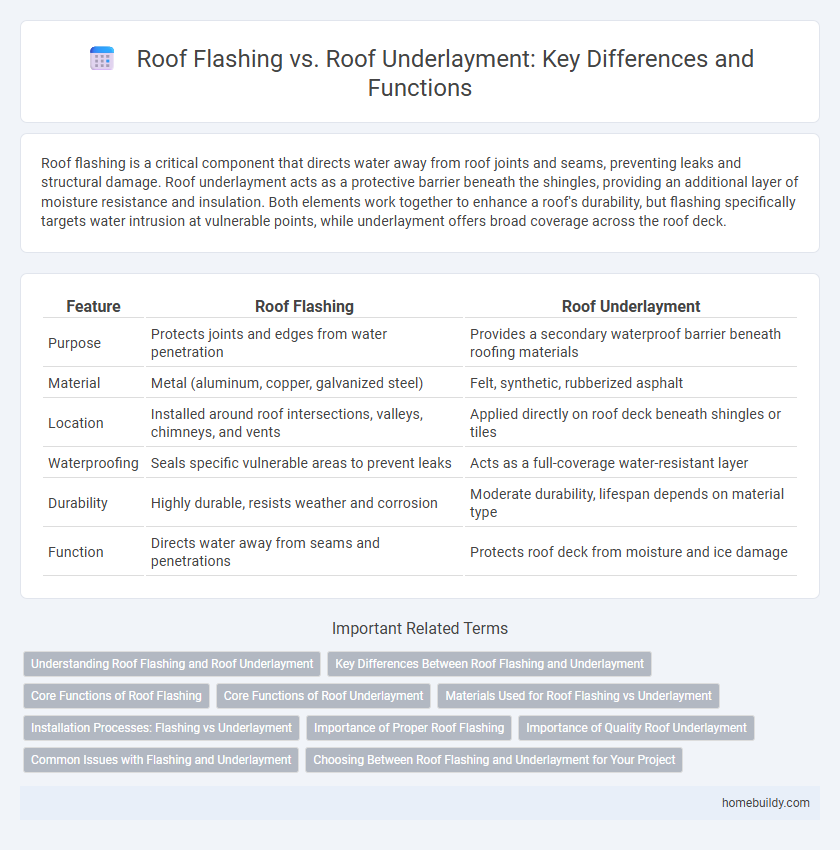Roof flashing is a critical component that directs water away from roof joints and seams, preventing leaks and structural damage. Roof underlayment acts as a protective barrier beneath the shingles, providing an additional layer of moisture resistance and insulation. Both elements work together to enhance a roof's durability, but flashing specifically targets water intrusion at vulnerable points, while underlayment offers broad coverage across the roof deck.
Table of Comparison
| Feature | Roof Flashing | Roof Underlayment |
|---|---|---|
| Purpose | Protects joints and edges from water penetration | Provides a secondary waterproof barrier beneath roofing materials |
| Material | Metal (aluminum, copper, galvanized steel) | Felt, synthetic, rubberized asphalt |
| Location | Installed around roof intersections, valleys, chimneys, and vents | Applied directly on roof deck beneath shingles or tiles |
| Waterproofing | Seals specific vulnerable areas to prevent leaks | Acts as a full-coverage water-resistant layer |
| Durability | Highly durable, resists weather and corrosion | Moderate durability, lifespan depends on material type |
| Function | Directs water away from seams and penetrations | Protects roof deck from moisture and ice damage |
Understanding Roof Flashing and Roof Underlayment
Roof flashing is a critical component designed to direct water away from roof joints and prevent leaks, typically made from metal such as aluminum or galvanized steel. Roof underlayment serves as a protective barrier installed beneath the shingles, providing secondary waterproofing and shielding the roof deck from moisture and weather damage. Both elements work together to enhance a roof's durability, with flashing addressing water intrusion at vulnerable seams and underlayment offering widespread moisture resistance.
Key Differences Between Roof Flashing and Underlayment
Roof flashing is a waterproof material installed around roof edges, joints, and penetrations to prevent water infiltration, whereas roof underlayment is a protective layer placed directly beneath the roofing materials to provide an additional barrier against moisture and weather elements. Flashing typically consists of metal such as aluminum or copper, designed to redirect water away from critical areas, while underlayment is often made from synthetic materials, felt, or rubberized asphalt for broad surface protection. Key differences include their placement, material composition, and primary function: flashing targets vulnerable transition points, whereas underlayment covers the entire roof deck as a secondary shield.
Core Functions of Roof Flashing
Roof flashing serves as a critical waterproof barrier that directs water away from vulnerable roof joints and seams, preventing leaks and structural damage. Unlike roof underlayment, which provides an additional layer of protection beneath roofing materials against moisture infiltration, flashing specifically seals areas around chimneys, vents, and skylights to ensure water-tight integrity. Proper installation of roof flashing enhances the roof's durability by safeguarding against water penetration where roofing materials intersect or change slope.
Core Functions of Roof Underlayment
Roof underlayment serves as a crucial secondary barrier beneath shingles or tiles, providing waterproof protection against water infiltration during severe weather or roof damage. Unlike roof flashing, which seals roof joints and edges to prevent leaks at vulnerable points, underlayment covers the entire roof deck, enhancing overall moisture resistance. High-quality underlayment materials like synthetic or felt options improve durability and extend the roof's lifespan by preventing rot, mold, and structural damage.
Materials Used for Roof Flashing vs Underlayment
Roof flashing is typically made from durable materials such as aluminum, copper, galvanized steel, or lead, designed to prevent water penetration at roof joints and seams. Roof underlayment, in contrast, usually consists of synthetic felt, rubberized asphalt, or peel-and-stick membranes that provide a secondary waterproof barrier beneath shingles or roofing materials. The distinct materials highlight flashing's role in directing water away from vulnerable areas, while underlayment serves as an overall protective layer guarding the roof deck.
Installation Processes: Flashing vs Underlayment
Roof flashing installation involves precise placement around roof edges, joints, and openings to prevent water infiltration, requiring specialized techniques for sealing and overlap. Roof underlayment installation consists of laying a continuous waterproof or water-resistant barrier beneath roofing materials, typically rolled out and fastened with nails or staples for uniform coverage. Both processes demand attention to detail, but flashing requires targeted application at critical points, while underlayment covers the entire deck surface.
Importance of Proper Roof Flashing
Proper roof flashing is essential for directing water away from vulnerable areas such as joints, chimneys, and vents, preventing leaks and structural damage. Unlike roof underlayment, which provides a secondary protective layer beneath shingles, flashing serves as a critical barrier against water intrusion at roof intersections. Effective installation of roof flashing enhances the roof's durability and extends its lifespan by safeguarding against moisture infiltration and related issues.
Importance of Quality Roof Underlayment
Quality roof underlayment serves as a critical secondary barrier against water infiltration, enhancing the protection provided by roof flashing. While roof flashing directs water away from vulnerable areas like chimneys or skylights, underlayment offers an extra layer of defense beneath the shingles, preventing leaks caused by wind-driven rain or ice dams. Investing in durable, high-performance underlayment materials significantly extends roof lifespan and reduces the risk of costly water damage.
Common Issues with Flashing and Underlayment
Common issues with roof flashing include improper installation leading to water infiltration and corrosion from exposure to harsh weather conditions. Roof underlayment problems often stem from inadequate coverage or damage during installation, causing reduced waterproofing and increased risk of leaks. Both elements require precise application to ensure the roof's long-term durability and protection against moisture intrusion.
Choosing Between Roof Flashing and Underlayment for Your Project
Roof flashing and roof underlayment serve distinct purposes in roofing projects: flashing directs water away from critical joints and seams, while underlayment provides a secondary waterproof barrier beneath shingles. Choosing between roof flashing and underlayment depends on the specific vulnerability of your roof area, with flashing being essential around chimneys, vents, and valleys, and underlayment used across the entire roof deck for overall protection. For optimal roof durability, integrating both flashing and underlayment is crucial to prevent leaks and water damage.
Roof flashing vs roof underlayment Infographic

 homebuildy.com
homebuildy.com